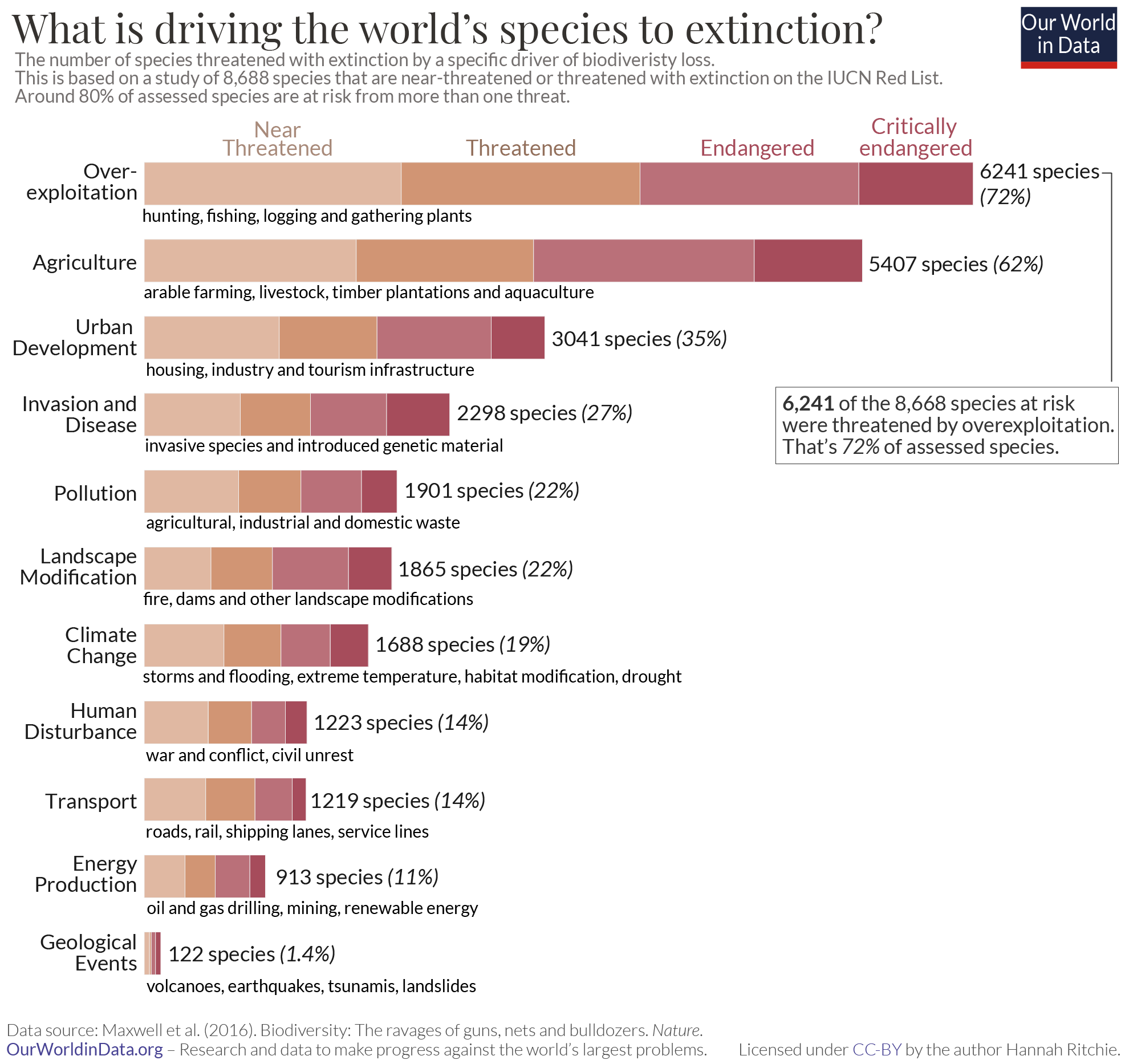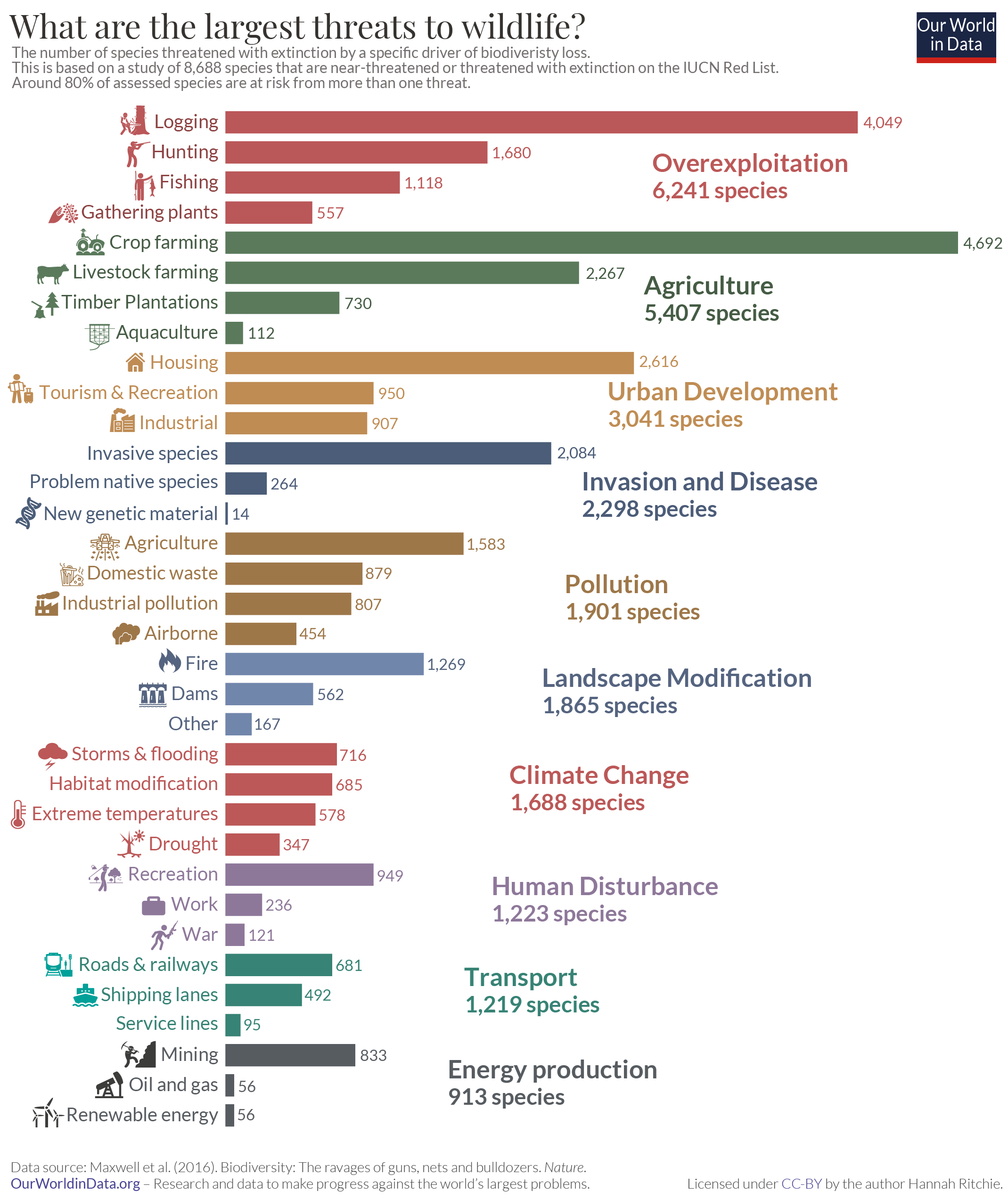Summary
- 80% of threatened species are affected by more than one threat.
- Overexploitation of natural sources – overhunting, overfishing and forest logging – threatens the largest number of species.
- Agriculture – the expansion of land for crops, livestock, timber and aquaculture – is another leading threat. This is driven by habitat loss, livestock competition and agricultural pollution.
- Human habitats and infrastructure – urban, transport and energy development – causes habitat fragmentation with large impacts on many species.
- Climate change is not among the largest threats to wildlife today, but its impact on species will continue to grow with further warming.
What are the largest threats to wildlife?
- Overexploitation and agriculture are the biggest threats to wildlife
- A closer look at the drivers of biodiversity loss
- The biggest threats today are the same as the biggest threats of the past
40% of the world’s amphibians; one-quarter of its mammals; and 14% of its birds are threatened with extinction. Many more species in less-studied groups such as insects, fish, fungi and plants are also at risk.
If we want to save these species we first need to know what’s driving them to extinction. What can we say about the largest threats to the world’s wildlife?
Overexploitation and agriculture are the biggest threats to wildlife

The IUCN Red List tracks the extinction status of thousands of species across the world and assesses the threats to each. In a study published in Nature, Sean Maxwell and colleagues documented the threats to 8,688 near-threatened and threatened species that have been fully assessed.1 This means this study will capture the threats of some taxonomic groups better than others. We know much more about the world’s mammals, birds, reptiles and amphibians than we do about its fungi and insects. All bird and mammal species have been assessed but only 0.1% of fungi species have. But most of the key drivers of extinction risk for these studied groups are similar to the lesser-studied ones: for example, insects are highly threatened by agriculture and habitat loss.
The headline message is that the largest threats to wildlife is overexploitation – the harvesting of animals for meat, products such as horns and medicines, logging, and fishing – and agriculture. These have been the largest threats to biodiversity for millennia, and this still holds true today.
In the chart, we see the number of species that are threatened by each group of threats. In the next section, we will break these down into greater detail. You will notice that these sum to much greater than the 8,688 threatened species that the authors studied. This is because more than 80% of the species were affected by more than one major threat. Species that are under threat from human poaching might also be under threat from deforestation and loss of their habitats.
Overexploitation is the biggest threat. Nearly three-quarters (72%) of the studied species – that’s 6,241 of them – were under pressure from hunting, fishing or logging of forests. Agriculture – which includes arable farming, livestock, timber plantations and aquaculture – was also a massive threat. Nearly two-thirds (62%) of species were affected.
These threats are not only the biggest pressures on all species that are near-threatened or threatened, we also see that they dominate for the species closest to extinction – the endangered and critically endangered ones.
A closer look at the drivers of biodiversity loss

Let’s look a little deeper at the breakdown of these high-level threat categories. So far we’ve grouped terrestrial hunting together with fishing; and timber plantations together with aquaculture. To target our efforts we need to understand these differences in more detail.
In the chart, we see their breakdown. These sub-threats are grouped and coloured by their high-level categories.
Agriculture and logging
Crop farming and logging are the biggest threats by far. They affect around half of these threatened species. Livestock agriculture – which includes direct competition with farmed animals and livestock disease, but not clearance of land for pasture – are all tightly linked. The expansion of land for agriculture is the leading driver of deforestation and habitat loss. 40% of tropical deforestation is driven by pasture for beef production; 18% for palm oil and soybeans; and another 13% for forest products such as paper and wood.
Deforestation and unsustainable logging threaten more than 4,000 species from the Indian Nicobar shrew, to the Bornean Wren-babbler, to the Myanmar snub-nose monkey. Competition and disease from livestock threaten species across all tropical continents: the cheetah in Africa; the hairy-nose otter in Asia and the huemul deer in South America.
Hunting and fishing
One-fifth of threatened species were at risk from hunting. For mammals, especially large mammals, hunting is the biggest threat by far. Animals are hunted for their meat, or for body parts such as horns, antlers, hands or trunks. Some of the world’s most treasured animals including the rhinoceros, Western gorilla, and Chinese pangolin are illegally hunted for their body parts. We look at the scale of poaching and wildlife trade in our related article here.
Fishing is also an important threat to many species. The average decline in global wild fish stocks has stabilized in recent decades – partly due to a rapid rise in aquaculture to meet demand – this is not true for all fish species. Some are still overexploited and populations cannot recover quickly enough. In a related article, we take a closer look at the state of the world’s fish stocks.
Human developments and habitat fragmentation
Human developments such as housing, industry, recreational development such as golf courses, and roads also threaten thousands of species. One of the biggest impacts of this infrastructure is its impact on habitat fragmentation. Even if these developments take up very little space in terms of total area, they cross vast landscapes. There is very little of the world’s landscape that is not close to some human development or transport link.
In a paper published in Science, Nick Haddad and colleagues looked at the impact of habitat fragmentation on ecosystems.2 Habitat fragmentation is the breakup and division of habitats into smaller and smaller chunks. Each of these fragments becomes isolated and separated from others by land that is transformed and used by humans.
Using high-resolution mapping of global tree cover, they found that 20% of the world’s forests were within 100 meters of an ‘edge’: some human use of the land such as a road, village, farm or plantation. More than 70% were within one kilometre of a forest edge. There are still some tropical forests that cover large areas and are relatively untouched: you find the largest expanses of unbroken forests in the Congo and some regions of the Brazilian Amazon. Other areas have been completely transformed. A couple of centuries ago 90% of the Brazilian Atlantic – forest that lies near the coast of the Atlantic Ocean – was at least one kilometre from a forest edge. Today less than 9% is.
This fragmentation has large impacts on ecosystems and species richness. The abundance of birds, insects and plants in experiments across all five continents fell by 20% to 75% when these ecosystems were fragmented.
Climate change
Climate change can affect biodiversity in many ways: storms and flooding, extreme temperatures, drought and changes in habitat. Hooded seals provide one stark example: their abundance in the northeastern Atlantic Arctic has declined by 90% in recent decades because of reduced sea ice. This means they have fewer sites for raising their offspring. But, climate change is lower on the list than many people expect. One reason is that this is based on current or near-term threats to wildlife. The impacts of climate change will continue to increase in the coming decades, and so this share is likely to increase.3 In an upcoming article we will look at the potential risk of climate change to biodiversity in more detail.
The biggest threats today are the same as the biggest threats of the past
Another reason that some people are surprised by how low climate change is on the list is that we just underestimate the persistent role that hunting, habitat loss and agriculture play in biodiversity loss. Most discussions around the environmental impacts of our food relate to greenhouse gas emissions and their contribution to climate change. But that’s just one of many impacts.
The biggest threat to wildlife is still how we produce food, whether we get it from crop farming, livestock, hunting, fishing or aquaculture. This has been the case for centuries. Overexploitation and agriculture were responsible for 75% of all plant, amphibian, reptile, bird and mammal species that have gone extinct since 1500 AD.4 In fact, it has been driving mammals to extinction for millennia. It’s an old problem that we tend to overlook in favour of newer, emerging ones, like climate change and plastic pollution.
But we are finally in a position where it’s possible to bring this to an end. Strict local enforcement on poaching and trade bans; improved marine management policies; zero-deforestation monitoring; a shift towards more plant-based diets; and increased crop yields will all play an essential role in combating the age-old problem of overexploitation and destruction of the ecosystems around us.
Specific threats to wildlife
- Poaching and wildlife trade
- Habitat loss
- Deforestation
- Ocean acidification
- Climate change
- Plastic pollution

